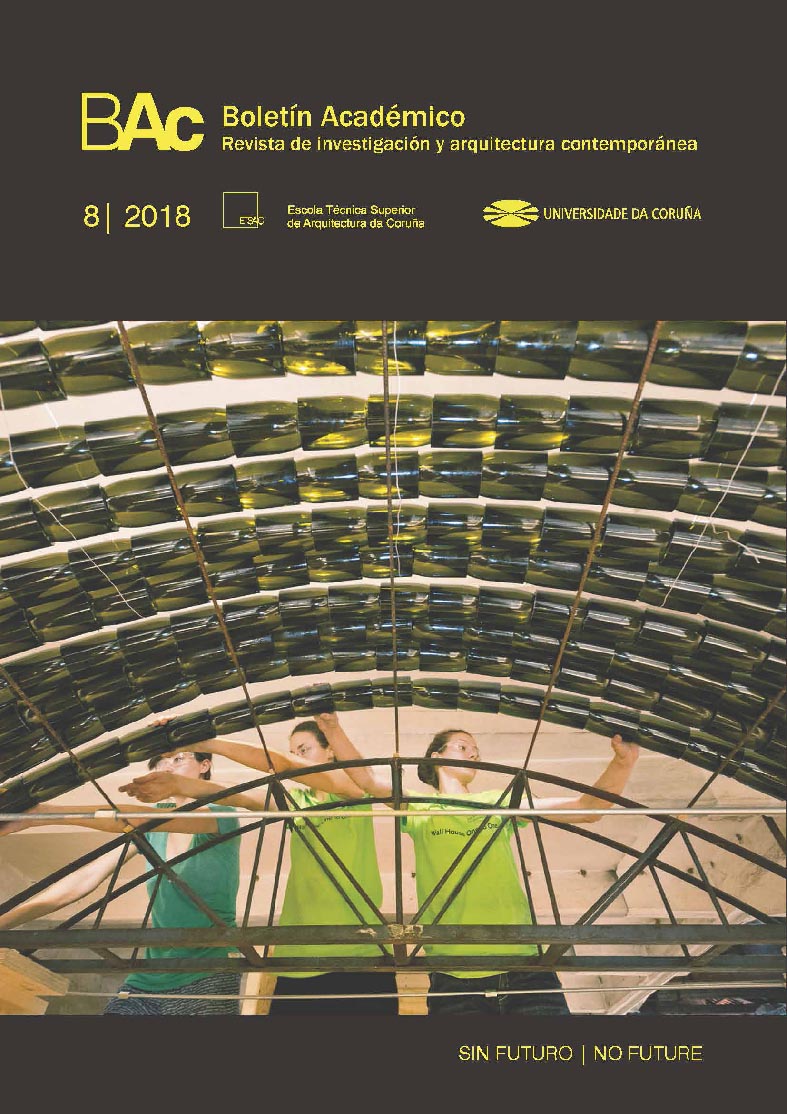Cosmonauts of the future. Transhousing experiences for post-welfare times.
Main Article Content
Abstract
Downloads
Article Details
References
Artieda, Koldo; Zarza, Rafael, y otros. Diseño sin diseño. Cincuenta objetos anarquistas. Madrid: Fundación de Estudios Libertarios Anselmo Lorenzo, Vacaciones en Polonia, 2013.
Arvatov, Boris; Kiaer, Christina. “Everyday Life and the Culture of the Thing (Toward the Formulation of the Question).” October 81 (1997): 119-28.
Bjögvinsson, Erling; Ehn, Pelle; Hillgren, Per-Anders. “Design Things and Design Thinking: Contemporary Participatory Design Challenges.” Design Issues 28:3 (2012): 101-16.
Bloch, Ernst. El principio esperanza. Madrid: Aguilar, 1980 [1959].
Blød By, 3 Almennyttigt Boligbyggeri, 1979.
Buchli, Victor. An archaeology of socialism. Sydney: Bloomsbury Academic, 2000.
Buck-Morss, Susan. “Aesthetics and Anaesthetics: Walter Benjamin's Artwork Essay Reconsidered.” October 62 (1992): 3-41.
Burrell, Gibson; Dale, Karen. “Building better worlds? Architecture and critical management studies,” en Studying Management Critically, editado por Mats Alvesson, Hugh Willmott, 177-96. London: Sage, 2003.
Caldenby, Claes. Vad är ett kollektivhus? Sammanfatting till en sammanläggningsavhandling byggd på böcherna. Kollektivhus. Sovjet och Sverige. Omkring 1930 och Kollektivhuset Stacken. Gotemburgo. Arkitekturens teori och historia CTA, 1992.
Debord, Guy. The society of the spectacle. London: Boureau of Public Secrets, 2014 [1967].
De Carlo, Giancarlo. “An architecture of participation.” Perspecta 17 (1980 [1972]): 74-79.
De Carlo, Giancarlo. “Architecture's public,” en Architecture and participation, editado por Peter Blundell Jones, Doina Petrescu y Jeremy Till, 4-12. Abingdon: Spon Press, 2005 [1970].
De Certeau, Michel. The practice of everyday life, Berkeley: Univ. Of California Press, 1984.
Gómez de Liaño, Ignacio. “Metáforas de la ciudad.” Archienemy 1 (2016): 66-75.
Harvey, David. Spaces of Hope. Edinburgh: Edinburgh University Press, 2000.
Jameson, Fredric. Archaeologies of the future, the desire called utopia and other science fictions. London: Verso, 2007.
Kaminer, Tahl. Architecture, crisis and resuscitation. New York: Routledge, 2011.
Kiaer, Christina. Imagine no possessions: the socialist objects of Russian constructivism. Cambridge(MA): MIT, 2005.
Kiaer, Christina. “Rodchenko in Paris.” October 75 (1996): 3-35.
Lefebvre, Henry. De lo rural a lo urbano. Barcelona: Península, 1978 [1971].
Lefebvre, Henry. The survival of capitalism. Reproduction of the relations of production. New York: Sant Martin's Press, 1976 [1973].
Le Guin, Ursula K. Los que se marchan de Omelas (Alcorcón: Biblioteca Anarquista la Revoltosa, 2016).
Manniche, Peter. Living democracy in Denmark: independent farmers, farmer’s cooperation, the folk high schools, cooperation in towns, social and cultural activities, social legislation, a Danish village. Copenhagen: G.E.C. Gad Pub., 1970 [1952].
Mella, Ricardo. El socialismo anarquista y otros textos. México: La voz de la anarquía, 2011 [1900].
Movilla Vega, Daniel; Espegel Alonso, Carmen. “Hacia la nueva sociedad comunista: la casa de transición del Narkomfin, epílogo de una investigación”, Proyecto, proceso, arquitectura 9 (2013): 26-49.
Puente, Isaac. El Comunismo Libertario y otras proclamas insurreccionales y naturistas. Bilbao: Likiniano Elkartea, 2003 [1936].
Rieiro Díaz, Rodrigo; Haugbølle, Kim. “(Im)posibilidades de la vivienda participativa, retornando al sistema Flexibo”, Proyecto, progreso, arquitectura 18 (2018): 42-56. DOI: http://dx.doi.org/10.12795/ppa.2018.i18.03.
Sangregorio, Inga Lisa, “Collaborative housing: The house of the future?,” en Gender and the Built Environment: Emancipation in Planning, Housing and Mobility in Europe, editado por Liesbeth Ottes, Erica Poventud, Marijke van Schendelen, Gertje Segond von Banchet, 101-14. Assen: Van Gorcum, 2005.
Sassen, Saskia. “The informal economy: Between new developments and old regulations.” The Yale Law Journal 103 (1984): 289-304.
Tafuri, Manfredo. “USRR-Berlin, 1922: From populism to “Constructivist International”,” en Architecture, criticism, ideology editado por Joan Ockman, 121-81. Princeton (NJ): Princeton Univ. Press, 1985.
Urban Vestbro, Dick. “History of cohousing – Internationally and in Sweden,” en Living together - Cohousing Ideas and Realities Around the World. Proceedings from the international collaborative housing conference in Stockholm 5-9 May 2010, editado por Dick Urban Vestbro, 42-55. Estocolmo: Division of Urban and Regional Studies, Royal Institute of Technology in collaboration with Kollektivhus NU, 2010.
Vacaciones en Polonia, 6. Madrid: Vacaciones en Polonia, 2011.
Ward, Colin. Housing, an anarchist approach. London: Freedom Press, 1976.
Weil, Simone. “Reflexiones sobre las causas de la libertad y de la opresión social,” en Profesión de fe. Antología y crítica alrededor de su obra, editado por Sylvia Valls, 111-47. México: Pleorama, 2006 [1934].



